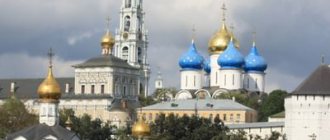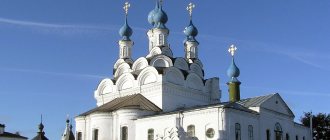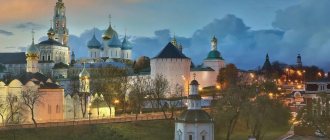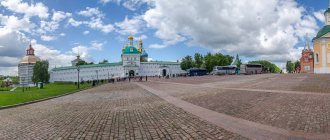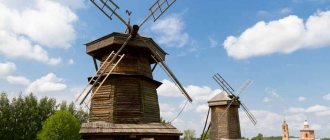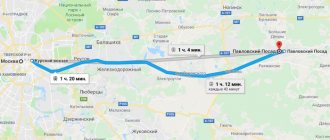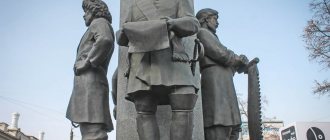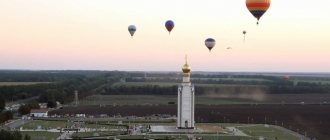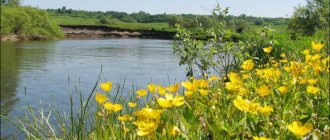Sergiev Posad – one of the most popular cities of the Golden Ring of Russia. Proximity to Moscow, good transport accessibility, rich historical and spiritual components make Sergiev Posad a very attractive tourist destination. At one time, Sergiev Posad was visited by such famous people as Gogol and Dostoevsky, Repin and Surikov, Tchaikovsky and Chaliapin.
Holy Trinity Lavra of Sergius in Sergiev Posad
General information
The city near Moscow has become a point of attraction for pilgrims. The amazing history of Sergiev Posad has opened up enormous opportunities for the development of the tourism sector.
The city is located 70 kilometers from the capital. About 100 thousand inhabitants live here. Sergiev Posad captivates travelers with its peaceful atmosphere. Here you can gain strength, cheer up, and make the right decision.
Here is the pearl of Russian Orthodoxy - the Holy Trinity Lavra of St. Sergius complex. But even if you bypass the monastery, there are many other, no less interesting attractions.
Every Russian should visit here at least once and touch the secret that these holy lands keep.
Chernigov monastery
The Chernigov monastery is located outside the territory of the Lavra, but is considered its courtyard. The word “skete” originally meant a desert, but then it began to be used for places of special, silent solitude in monasteries.
The Chernigov monastery is a complex of cave temples, a five-domed ground temple, a bell tower and a long wall-like cell building.
All buildings are red with white trim, they are designed in the same architectural style. The Chernigov monastery stands on the picturesque shore of a vast pond.
History of the city of Sergiev Posad
The city is named after the saint known as Sergius of Radonezh. He founded a monastery. The date of creation of the monastery is said to be 1345. The shrine became famous throughout Rus'. Dmitry Donskoy came here for a blessing before the great Battle of Kulikovo.
Over time, a settlement began to form around the monastery. The following points are considered important dates in the history of the existence of Sergiev Posad:
- 1408 The first monastery was burned by Mongol-Tatar nomads who captured Rus'.
- 1411 A new monastery was built. From that time on, the appearance of the city began to take shape. Slobodas arose. Already at that time there were such settlements as Pushkarskaya, Ikonnaya and others.
- 1422 The first stone temple was erected. Later, the founder, Sergei of Radonezh, was buried within its walls. The monastery continued its existence in subsequent centuries, receiving new novices and noble guests who came for blessings.
- 1744 The monastery gained importance. He was given the status of Lavra.
- 1782 The independent history of the city of Sergiev Posad begins. Residents were engaged in trade and served pilgrims who flocked to the monastery in large numbers.
- 1814 The first theological academy opened in the city. The number of clergy increased during these years. The bulk of the population were people close to the church.
- 1920 The monastery has been converted into a museum. It still matters to people. But the Soviet government condemns religious views.
- 1930 The city is named Zagorsk. In this way, the authorities are trying to reduce citizens’ interest in the shrine.
- 1991 The settlement is returned to its former name. The monastery is being revived. People all over the world are once again interested in holy places.
Today Sergiev Posad is a significant place for pilgrims. There are over 250 historical and cultural monuments located in the city. The tourism infrastructure is actively developing.
It is better to come here for 2-3 days. Then you will be able to get acquainted with all the significant sights. Mostly pilgrims and those interested in religious architectural monuments come here.
Source of St. Savva of Storozhevsky
Savva Storozhevsky was a student and ally of Sergius of Radonezh. He lived for a long time in the Trinity-Sergius Monastery, and then founded his own, the Savvino-Storozhevsky Monastery in Zvenigorod.
The source comes out of the ground almost directly behind the wall of the Lavra. There is a chapel nearby. The area around the source is equipped with changing rooms and swimming pools - you can not only collect healing water, but also swim in it. Near the spring there are kiosks selling swim shirts, towels and souvenirs.
Sights of Sergiev Posad
The main attraction, the pearl of the city, is the Trinity Lavra of St. Sergius. Thanks to her, Sergiev Posad was formed. Trinity-Sergius Lavra is an architectural ensemble consisting of temples, churches, cathedrals.
The Trinity Cathedral is noteworthy. This is a 15th century monument. Within its walls is an iconostasis, on which Andrei Rublev, a famous Russian icon painter, worked.
Visitors examine the Holy Spiritual Church, a 5-tier bell tower, the Temple of Sergius of Radonezh and other objects located on the territory of the complex.
According to legend, two monks came here in the 14th century: Bartholomew and Stephen. They founded a monastery, which marked the beginning of the Trinity-Sergius Lavra.
The Assumption Cathedral also deserves attention. This is a monument from the mid-16th century. In general, the Trinity-Sergius Lavra is located in the very center of the city. It is impossible to pass by her. It serves as a monastery.
Buildings from the 16th, 17th, 18th, 19th and 20th centuries have been preserved on the territory of the complex. About 200 monks live within the walls of the monastery.
Excursions are organized for visitors every day. The accompanying person introduces you to the iconic sights and life of the monks.
In addition to the Trinity-Sergius Lavra, there are other attractions in the city that deserve special attention. First of all, these are the Pyatnitsky well, the monument to Sergei of Radonezh and museum institutions.
Visit the Skitskie Prudy park. In summer there is a skate zone, children's playgrounds and carousels.
If you want to admire the Trinity-Sergius Lavra from above, go to Pancake Mountain. From here you can see the immediate surroundings. The hill received its name at the end of the 19th century. Pancakes were baked here, which were enjoyed not only by visiting pilgrims, but also by local residents.
If time permits, explore the following attractions:
- Park of Wonders:
- Husky House;
- Museum of the Moscow Theological Academy;
- Monument to “Victims of the Years of Persecution and Repression”;
- Source of St. Savva of Storozhevsky.
Sergiev Posad is full of attractions. It is impossible to study it completely even in a few days. Picturesque views and a peaceful environment encourage leisurely walks and exploring interesting sites.
Where else to take a walk in Sergiev Posad
Red Army Avenue
After lunch, we suggest taking a walk along the main street of the city - Red Army Avenue
to the right of the Lavra. This is the longest and widest street, carefully preserving ancient historical buildings of previous centuries. In the 18th century, the current avenue was just part of the road route from Moscow to the city of Pereslavl-Zalessky, and it was then called Bolshedorozhnaya Street.
Red Army Avenue
The walk will give you aesthetic pleasure with the well-groomed view of the cozy town of Sergiev Posad (Zagorsk), plus - in numerous shops you can buy memorable souvenirs
(more details - What to bring from Sergiev Posad), as well as explore the original modern museums of the city and see the interesting historical and architectural monuments that you will find on this street.
Pyatnitskaya and Vvedenskaya churches
Almost immediately behind the Lavra, or rather behind its south-eastern corner, there are two churches that you can’t help but pay attention to. These are the oldest churches: Vvedenskaya Church
and
the Church of Paraskeva Pyatnitsa
(127 Red Army Ave.), forming a harmonious composition.
In the old days, a trade route passed here, and there was a market square on which there was a wooden Church of the Entry into the Temple of the Blessed Virgin Mary with the chapel of Paraskeva Pyatnitsa, built at the beginning of the 15th century. In the middle of the 16th century. - with donations from the boyar governor I.I.
Khabarov and parishioners, instead of one wooden one, two stone churches were built.
Vvedenskaya and Pyatnitskaya churches
Vvedenskaya
– a cross-domed church with one gilded dome and without a belfry.
She is strict and majestic, and represents the vertical of the composition. And the Church of Paraskeva Pyatnitsa
is a three-part temple, similar to a ship, in unity with which there is
a bell tower
, decorated with numerous decorative elements. This church is light, elegant and cozy and represents a horizontal composition. During the Soviet years, both churches had storage facilities, but after restoration they acquired their previous appearance.
Chapel of the Pyatnitsky Well
Next to the ensemble of two churches is the Pyatnitsky Well Chapel
.
This is a small structure of three tiers, inside of which there is a spring. This source was discovered by St. Sergius
, and it was from here that he carried water for his monks to Mount Makovets.
Chapel of the Pyatnitsky Well
Continuing along the pedestrian path, you will reach the Memorial of Glory with the Eternal Flame
.
Toy Museum
Further, along the path and the openwork bridge of the newlyweds across the Kopninka River, you will rise to the unique “Art and Pedagogical Museum of Toys”
(Red Army Ave., 123), which we highly recommend paying attention to.
This museum, which grew out of the private collection of art historian N.D. Bartram
, is located in an old red brick building, a former commercial school.
Toy Museum
The museum contains a huge number of exhibits dating back to the 11th century. Such specimens as the first Russian nesting doll, made in the image of a Japanese toy - a bald old man, or funny things that the children of Nicholas II played with, will not leave you indifferent and will allow you to spend time in a very entertaining and interesting way.
Exhibits of the Toy Museum in Sergiev Posad
And for art lovers, the museum has a special corner called “Children’s Portrait”
, which presents little-known paintings by masters of painting from the 17th to 20th centuries.
Kelarsky Pond
If you have time and energy left, turn right to the famous Kelarsky pond
and take a walk around it. This artificial reservoir was built by monks in the 16th century. In subsequent times, the pond was expanded and improved. It's a good place to relax - in the summer you can go boating, or just admire the surroundings and take photos.
Kelarsky Pond
Walking around the Kelarsky pond, you can walk to the Elias Church
(Kuzminova, 1/5).
This is an architectural structure in the Baroque style of the second half of the 18th century
. Dark red walls, white trim and relief patterns - everything is strict and elegant. An interesting fact is that this was the only functioning church in the city during Soviet times.
Elias Church
And the story
its construction is very interesting. Previously, there was the village of Panino, where in the 17th century a wooden Kazan Church with a chapel of the Prophet Elijah was built. In the 18th century, due to dilapidation, the chapel was dismantled and a new church was erected - Ilinskaya, which soon burned down in a fire. Then the stone Ilinskaya Church was erected, which was in great harmony with the wooden Kazan Church. But in the 30s, the Kazan Church was destroyed.
In addition to the Ilinskaya Church, near the Kelarsky Pond you can see the Monument to Peter and Fevronia of Murom
.
Monument to Peter and Fevronia of Murom
Further, continuing along Red Army Avenue, you can look into the Museum of Folk Crafts
(Krasnaya Armii Ave., 105), located in a former merchant's house, where you can see wooden sculptures of saints and buy some original toy souvenir.
And a little further south along the avenue there is the blue and white Church of the Ascension of the Lord
(Red Army Ave. 88a), erected in the second half of the 18th century in the
Baroque
.
The church was conceived as a two-story building, but due to a lack of funds, it was built in a somewhat mundane form, which is compensated by a high, elegant three-tier bell tower and stucco decorations on the facades. Before it, there was a wooden parish church for parishioners of the Rybnaya and Icon settlements (17th century). In the 18th and 19th centuries, the main square of the city, Voznesenskaya, was located in front of the temple.
Church of the Ascension
And now there’s just a little bit left to do – walk to Kooperativnaya
, and then along it to Vokzalnaya Square, on which there is a monument to the famous sponsor of the local railway line,
Savva Mamontov
. He sits opposite the station building, meeting and seeing off all the guests of Sergiev Posad.
Monument to philanthropist Savva Mamontov
City museums
If you visit Sergiev Posad on your own, don't miss out on the unusual Toy Museum. Its exhibition includes more than 150 thousand of a wide variety of items created by craftsmen for the enjoyment of children. There are toys from both foreign and domestic masters. Sergiev Posad is even known in the world as the “Capital of the Kingdom of Toys”. Therefore, you can take children on the trip too. They won't be bored.
Legend has it that toys were made on the territory of the Trinity-Sergius Lavra 200 years ago. Local residents sold them to pilgrims who arrived to visit the monastery.
Be sure to check out the Museum of Soviet Childhood. Here are collected toys and board games that replaced gadgets for children in the last century. Adults speak highly of the visit. They claim that it is as if they were momentarily transported back to their childhood.
Visit the Sergiev Posad Museum-Reserve. It was founded 100 years ago, and its fund includes over 100 thousand storage units. There are icons, silver utensils, religious objects, and paintings by famous painters.
The Horse Yard is popular. This is also a museum. Previously, the building housed a stable. Now there are several regular exhibitions within the walls of the Horse Yard. One of them is dedicated to the Russian nesting doll. Other exhibitions tell about life in the Russian village and about applied art. Real masterpieces created by the hands of folk craftsmen are exhibited here.
The Museum of Peasant Life "Once Upon a Time" belongs to V. Bagrov. A local artist has put together a unique collection. You can admire homespun clothes made in the last century, clay and wooden household items, kitchen utensils, and a collection of semi-precious stones.
In the house of Pavel Florensky, who is called the Russian Leonardo de Vinci, the furnishings that existed during the life of the priest, scientist, and painter have been preserved. There is a piano here. The brilliant inventor made it with his own hands. He was shot by the Bolsheviks. You can walk around Sergiev Posad all day and discover more and more new sights. We have listed only the most popular among tourists, but the list of religious monuments, museums, and exhibitions does not end there.
Significant dates
Today in history
- 104 years old
104 years ago, on January 20, 1918, the Decree of the Council of People's Commissars of the RSFSR “On the separation of church from state and school from church” was issued.
98 years ago, on January 21, 1924, a re-enactment on the events of January 9, 1905 took place on Red Square.
52 years ago Census in the Zagorsk region in 1970
412 years ago January 25, 1610 Anniversary of the end of the siege of the Trinity-Sergius Lavra
- 98 years old
98 years ago, January 27, 1924, on the day of the funeral of V.I. Lenin, a funeral meeting is being held in the building of the city theater.
- 104 years old
104 years ago In January 1918, electrical engineering courses were created.
104 years ago In January 1918, the Institute of Public Education was formed for the training of teaching staff, headed by Professor S.S. Glagolev.
- “In the 1340s,” describes Epiphanius the Wise, who compiled the biography of Sergius of Radonezh at the beginning of the 15th century, “in a dense forest on the Makovets hill at the confluence of the Konchura river with the forest stream Vondyuga, the brothers Bartholomew (in monasticism Sergius) and Stephen cut down a cell and a small church in honor of the Trinity." Around the cell and the church a small monastery was formed in the form of a town, surrounded by a fence, where monks, followers of Sergius of Radonezh, served.
- In 1380, Prince Dmitry Donskoy, according to a later unreliable legend, arrived at the monastery of Sergius of Radonezh for a blessing before the battle on the Kulikovo Field with the troops of the Golden Horde.
- St. Sergius died in 1392. In 1422, the canonization of St. Sergius took place and the laying of the white stone Trinity Cathedral over his grave inside the monastery took place.
- In 1408, the monastery was burned to the ground by the Tatar Khan Edigei, who launched another devastating campaign against Moscow and its environs.
- Ivan the Terrible was baptized in the monastery, who contributed to the transformation of the monastery into a powerful fortress that had important defensive significance for the Moscow region. Instead of a wooden fence in 1540-1550. a powerful wall with towers made of brick and stone was built. Ivan the Terrible, according to his will, was buried in the Archangel Cathedral of the Moscow Kremlin.
- In 1608-1610. The monastery was under siege by Polish-Lithuanian troops for 16 months.
- Peter I maintained the significance of a royal and important state fortress and visited the monastery more than once, and in 1689, during the Streltsy riot in Moscow, young Peter took refuge behind the walls of the monastery.
- In 1744, by decree of Empress Elizabeth Petrovna, the monastery was awarded the honorary title of Lavra, which strengthened its status role among other church institutions.
- In 1845, a highway was built connecting Sergievsky Posad with Moscow.
- In 1862, Savva Morozov built a railway line that included the Sergiev Posad station.
- In 1919, the city was named Sergiev, it became the center of Sergievsky district.
- In 1930 it was renamed Zagorsk in honor of the revolutionary figure V. M. Zagorsky.
- On January 20, 1930, the city of Sergiev was renamed Zagorsk, and the district was renamed Zagorsky District.
- On May 20, 1930, Bulakovsky and Novlensky s/s were transferred from Shchelkovsky district to Zagorsky.
- On November 13, 1931, the Trinity-Slobodsky s/s was abolished.
- On May 10, 1935, Yazvitsky s/s was abolished.
- On October 27, Bulakovsky and Novlensky s/s were returned to the Shchelkovsky district.
- On April 5, 1936, the Malyginsky and Yaryginsky s/s were abolished.
- On December 26, 1938, the working village of Khotkovo was formed. Khotkovsky s/s was abolished.
- On July 17, 1939, Bogorodsky, Vikhrevsky, Grigorkovsky, Deulinsky, Zubtsovsky, Novinkovsky, Smenovsky, Chizhevsky and Yakovlevsky s/s were abolished. Kozitsynsky s/s was renamed Bereznyakovsky, Torgashinsky - Okhotinsky, Saburovsky - Alferevsky.
- On September 19, the village of plant No. 11 was transformed into a settlement. Krasnozavodsky.
- On July 6, 1940, the holiday village of Semkhoz was formed.
- October 7 r.p. Krasnozavodsky was transformed into the city of Krasnozavodsk.
- On March 7, 1941, Zagorsk received the status of a city of regional subordination.
- On March 5, 1943, the village of Mukhanovo was transferred from the Struninsky district of the Ivanovo region to the Zagorsky district.
- On April 22, Mukhanovo received the status of a workers' village.
- July 27, 1949 r.p. Khotkovo received city status.
- On May 22, 1952, a d.p. was formed. Abramtsevo.
- On June 14, 1954, Alferevsky, Gorbunovsky, Divovsky, Dushishchevsky, Ereminsky, Iudinsky, Leonovsky, Malinnikovsky, Morozovsky, Ozeretsky, Okhotinsky, Repikhovsky, Svatkovsky, Sosninsky, Teshilovsky and Sharapovsky s/s were abolished. Buzhaninovsky, Kamensky and Mitinsky s/s were formed.
- On December 7, 1957, Bogorodsky, Veriginsky, Zabolotevsky, Skovorodinsky, Konstantinovsky, Kuzminsky, Novoshurmovsky, Selkovsky, Khrebtovsky and Chentsovsky s/s s/s of the abolished Konstantinovsky district were annexed to the Zagorsky district.
- On December 30, 1959, Akhtyrsky, Zabolotevsky, Novoshurmovsky and Selkovsky s/s were abolished. Khrebtovsky s/s was renamed Torgashinsky.
- On February 1, 1963, the Zagorsky district was abolished. At the same time, the cities, summer cottages and workers' settlements that were part of it were transferred to the subordination of the city of Zagorsk, and the village councils were transferred to the Mytishchi enlarged rural district.
- On January 22, 1965, the Zagorsk district was restored to its previous composition.
- On December 2, 1976, Vorontsovsky and Maryinsky s/s were abolished.
- On October 25, 1984, r.p. were formed. Bogorodskoe and Skoropuskovsky. Vypukovsky s/s was abolished.
- On August 27, 1990, Kamensky s/s was renamed Maryinsky, and Bogorodsky - Shaburnovsky.
- On January 9, 1991, Selkovsky s/s was formed.
- On September 23, 1991, the city returned its historical name Sergiev Posad.
- On February 3, 1994, village councils were transformed into rural districts.
- On March 28, 2000, the city of Peresvet was formed.
- September 14, 2004 d.p. Semkhoz was annexed to Sergiev Posad. At the same time d.p. Abramtsevo and r.p. Mukhanovo were transformed into rural settlements.
What to see in the vicinity of Sergiev Posad
15 km from Sergiev Posad there is an amazing open-air ethnic park “Nomad”. Here are the dwellings of nomadic tribes. You will be able to get acquainted with the life, culture and traditions of different nationalities. In addition, you will see exotic animals: deer, northern dogs, Kalmyk camels, yaks and other representatives of northern latitudes.
The Abramtsevo estate also deserves attention. This is a kind of museum-reserve. S. Aksakov once lived here, and later Savva Mamontov began to own the estate. No less famous guests came to the estate to visit the famous owners. The estate is located 20 kilometers from the city.
Guests of Sergiev Posad certainly go to Gremyachiy Klyuch. This source, as local legend says, was begged by Sergius of Radonezh. Its waters are considered healing. People come here to ask the Almighty for health. The territory is landscaped. The attraction is located 28 km from the city.
The Muranovo Estate Museum is 30 km from Sergiev Posad. At one time, people who belonged to the sphere of writers lived here; F. Tyutchev was among the owners. The main exhibitions are dedicated to him. The idea of creating such an institution belongs to the leader of the Soviet people - V. Lenin.
And the village of Vasilyevo will appeal to fans of folklore. 40 kilometers from the city is the Museum of Slavic Fairy Tales and Mythology. Young travelers really like the interactive complex.
In Khotkovo (15 km) there is an interesting institution - the Raccoon House. Here you can observe the life and habits of the animals, feed them and take memorable photographs.
State Historical, Artistic and Literary Museum-Reserve "Abramtsevo"
Historical, artistic and literary museum-reserve…
Sergiev Posad district
On the banks of the Vori River, not far from Sergiev Posad, the Abramtsevo Museum-Reserve is located. In the middle of the 18th century, a manor appeared here, which became a source of inspiration for famous writers and artists. In 1843, the writer Sergei Aksakov acquired the estate; writers Nikolai Gogol and Ivan Turgenev, actor Mikhail Shchepkin, and historian Mikhail Pogodin liked to stay with him. In 1870, the house was bought by philanthropist Savva Mamontov - then the Abramtsevo art circle was formed here, which included artists Konstantin Korovin, Ilya Repin, Valentin Serov, Vasily Polenov, Viktor Vasnetsov and others.
After the revolution, a museum was opened in the estate, but the traditions of the Mamontov circle did not stop - in the 20th century, artists Pyotr Konchalovsky, Igor Grabar, Ilya Mashkov, sculptors Boris Korolev and Vera Mukhina worked in Abramtsevo. Today, the collection of the Abramtsevo Museum contains more than 25 thousand exhibits - photo archives and personal belongings of the former owners of the estate, graphics, paintings, sculptures and works of folk art.
Interesting Facts
There are interesting facts associated with the city. In general, this area is rich in stories and legends. You can get complete information about them on the excursion. We definitely recommend using the services of guides and then exploring the city and its surroundings on your own.
So, let's present the 10 most interesting facts:
- Sergiev Posad is included in the list of the most ancient cities of the Russian Federation.
- The area of the city is 50x50 sq. kilometers. It is twice the size of the Pacific country of Tuvalu.
- This is the only city of the Golden Ring located in the Moscow region.
- The Trinity-Sergius Lavra includes more than fifty architectural objects, and the entire complex is protected by UNESCO.
- It is believed that Sergiev Posad is the birthplace of the Russian nesting doll.
- At one time, N. Gogol, L. Tolstoy, A. Akhmatova, Yu. M. Lermontov came here.
- Ivan the Terrible was baptized in a local church.
- More than 300 thousand pilgrims come to Sergiev Posad every year. At the same time, the Chinese make up more than half of the tourists.
- There are only two laurels in Russia. One of them is located in St. Petersburg.
- The Trinity-Sergius Lavra houses the largest bell on the planet. Its weight is 72 tons.
You will learn even more interesting facts when visiting the city.
What to bring from Sergiev Posad as a gift
There are souvenir shops around the Trinity-Sergius Lavra. Here is the largest selection. Can buy:
- colorful headscarves;
- icons and religious literature;
- designer products (boxes, bracelets, egg coasters, etc.);
- religious paraphernalia (crosses, icons, chains, rings with the inscription “God bless me”).
In addition, in Sergiev Posad you will certainly come across shops with wooden toys: nesting dolls, whistles, animal figurines.
You can go to the village of Bogorodskoye. It is located 29 kilometers away. The famous Bogorodsk toys are made there. These are carved figures made of soft wood.
Be sure to try the monastery pastries. It is sold not only in the territories of the monasteries, but also outside them. You will be able to enjoy the pies even if you do not belong to the category of pilgrims.
And, of course, there are a lot of magnets and calendars with views of the city.
Where is Sergiev Posad and how to get there
Sergiev Posad is located approximately 70 kilometers from Moscow. It is best to go by personal transport. So, you can calmly and leisurely explore all the sights. Use the navigator.
Bus number 338 goes to Sergiev Posad. You can also get there by train. The distance by rail is only 70 km. They depart daily from Yaroslavsky Station. The average ticket price is 200 rubles. Electric trains run from early morning until late evening.
Fast commuter trains also come here. They also depart from Yaroslavsky railway station. The cost of an express ticket is slightly higher, but you will get there comfortably and faster.
If suddenly there are no tickets for electric trains or express trains, take the train that goes to Vologda or Yaroslavl via Sergiev Posad. You can get there in just an hour. A ticket costs from 500 to 1000 rubles.
There are hotels in Sergiev Posad.
They are designed for the “middle class”. The rooms are available; if necessary, you can always stay here overnight. There is no point in saving time on getting to know the sights of Sergiev Posad. Share interesting information with friends
